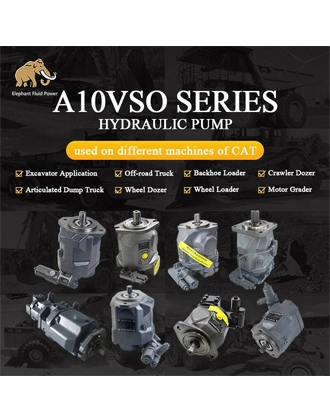There are many parts of hydraulic pumps, and here are some of the main ones:
First, Power Input Components
1. Drive shaft: connect the prime mover (such as motor and engine) with the hydraulic pump, and transmit the mechanical energy of the prime mover to the hydraulic pump to make the components in the pump run.
2. Coupling: It is used to connect the drive shaft and the output shaft of the prime mover, which plays the role of transmitting torque, compensating the relative displacement of the two shafts and buffering and damping.
1. Pump casing: It is the shell of the hydraulic pump, which is mainly used to accommodate and protect various internal parts, and at the same time guide the flow direction of the liquid.
2. Cylinder block: It is a key component of hydraulic pumps such as plunger pumps, with multiple plunger holes inside, in which the plunger reciprocates and moves to achieve the functions of oil suction and oil discharge.
Third, moving parts
1. Plunger: cooperate with the cylinder block, do reciprocating motion in the cylinder body, and realize oil absorption and oil pressure through the change of volume between the plunger and the cylinder bore.
2. Rotor: It is more common in vane pumps and gear pumps, and the rotor is equipped with blades or gears to promote the flow of liquid by rotation.
3. Blades: installed in the rotor groove of the vane pump, with the rotation of the rotor, the blades expand and contract in the rotor groove under the action of centrifugal force and hydraulic pressure, and form a variable volume with the inner surface of the stator to achieve the functions of oil absorption and oil discharge.
Fourth, Sealing parts
1. Sealing ring: used to prevent hydraulic oil leakage in the pump, the common ones are O-ring, Y-ring, V-ring, etc., which are installed in the piston, plunger, pump shaft and other parts of the cylinder or pump shell.
2. Gasket: Usually made of rubber, asbestos or metal and other materials, it is used to seal the joint surface of the pump casing, the connection between the end cover and the pump body, etc., to prevent oil leakage and external impurities from entering.
Fifth, Control parts
1. Safety valve: When the pressure in the hydraulic system exceeds the set value, the safety valve is opened to return the excess oil to the oil tank to protect the components in the hydraulic system from the damage of excessive pressure.
2. Flow control valve: used to adjust the flow output of the hydraulic pump to meet the speed requirements of different working parts.
Sixth, Accessories
1. Oil filter: installed at the suction port or return port of the hydraulic pump, which is used to filter impurities, particles and pollutants in the hydraulic oil, ensure the cleanliness of the hydraulic oil, and prevent impurities from entering the pump to cause wear or blockage.
2. Cooler: In some high-power hydraulic systems, the hydraulic pump will generate a lot of heat when working, and the cooler is used to reduce the temperature of the hydraulic oil to ensure the normal working temperature range of the hydraulic system.
Hydraulic pump parts list
Hydraulic pump parts catalog
 French
French
 Portuguese
Portuguese
 Russian
Russian
 German
German
 Spanish
Spanish
 Japanese
Japanese
 Korean
Korean
 Irish
Irish
 Greek
Greek
 Turkish
Turkish
 Italian
Italian
 Danish
Danish
 Romanian
Romanian
 Indonesian
Indonesian
 Czech
Czech
 Afrikaans
Afrikaans
 Swedish
Swedish
 Polish
Polish
 Basque
Basque
 Catalan
Catalan
 Esperanto
Esperanto
 Hindi
Hindi
 Lao
Lao
 Albanian
Albanian
 Amharic
Amharic
 Armenian
Armenian
 Azerbaijani
Azerbaijani
 Belarusian
Belarusian
 Bengali
Bengali
 Bosnian
Bosnian
 Bulgarian
Bulgarian
 Cebuano
Cebuano
 Chichewa
Chichewa
 Corsican
Corsican
 Croatian
Croatian
 Dutch
Dutch
 Estonian
Estonian
 Filipino
Filipino
 Finnish
Finnish
 Frisian
Frisian
 Galician
Galician
 Georgian
Georgian
 Gujarati
Gujarati
 Haitian
Haitian
 Hausa
Hausa
 Hawaiian
Hawaiian
 Hebrew
Hebrew
 Hmong
Hmong
 Hungarian
Hungarian
 Icelandic
Icelandic
 Igbo
Igbo
 Javanese
Javanese
 Kannada
Kannada
 Kazakh
Kazakh
 Khmer
Khmer
 Kurdish
Kurdish
 Kyrgyz
Kyrgyz
 Latin
Latin
 Latvian
Latvian
 Lithuanian
Lithuanian
 Luxembourg
Luxembourg
 Macedoniar
Macedoniar
 Malagasy
Malagasy
 Malay
Malay
 Malayalam
Malayalam
 Maltese
Maltese
 Maori
Maori
 Marathi
Marathi
 Mongolian
Mongolian
 Burmese
Burmese
 Nepali
Nepali
 Norwegian
Norwegian
 Pashto
Pashto
 Persian
Persian
 Punjabi
Punjabi
 Serbian
Serbian
 Sesotho
Sesotho
 Sinhala
Sinhala
 Slovak
Slovak
 Slovenian
Slovenian
 Somali
Somali
 Samoan
Samoan
 Scots Gaelic
Scots Gaelic
 Shona
Shona
 Sindhi
Sindhi
 Sundanese
Sundanese
 Swahili
Swahili
 Tajik
Tajik
 Tamil
Tamil
 Telugu
Telugu
 Thai
Thai
 Ukrainian
Ukrainian
 Urdu
Urdu
 Uzbek
Uzbek
 Vietnamese
Vietnamese
 Welsh
Welsh
 Xhosa
Xhosa
 Yiddish
Yiddish
 Yoruba
Yoruba
 Zulu
Zulu







